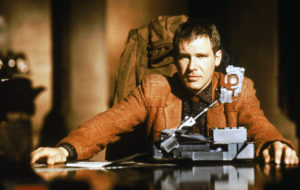J.G. Ballard’s posthumous status verges on the mythological: he’s a prophet, a visionary, who set on paper arcane and obscene predictions that have come unerringly true. Everywhere we look, we discover that we’re now living in Ballard’s world. As I wrote in my introduction to his selected nonfiction, referring to the plot of his final novel, Kingdom Come, “the next riot in a shopping mall seems perpetually five minutes into the future”. Ballard, we know, was prescient: the Seer of Shepperton.
Which might make what I’m about to argue seem perverse, but here goes. Ballard possessed no supernatural gift of foresight. He was an exceptional writer — one of the greatest of the 20th century — and the possessor of both a powerful imagination and a rare intellectual courage. Most pertinently, he was an extremely acute cultural analyst and observer. He was not a fortune teller. No science-fiction writer is. He was something much more powerful: a diagnostician.
The very idea of prediction is a consoling notion we use to make sense of the terrifying randomness of life and the singular direction in which time’s arrow flies. The notion that science fiction can defy these brute facts of thermodynamics is thrilling: if only we can unearth the correct tracts, we will know what will come to pass. E.M. Forster’s story “The Machine Stops” is an early example often claimed for the futurological argument. It seems uncanny that, as early as 1909, the author who would become famous for his novels A Room with a View and Howard’s End predicted a world in which, due to some form of environmental disaster, humans communicate trans-globally via screens. How did he know? What had he seen?
What he had seen — and experienced — was the telephone, which was proliferating through the more sophisticated houses of London in the Edwardian period, in which Forster hung out, and which allowed people to talk to each other without leaving their homes. He’d also read H.G. Wells’s A Modern Utopia, and, with some justification, was critical of its promotion of an oligarchic, technocratic society. So, he wrote a story that depicted an automated society in collapse. In short, Forster’s “vision” was responsive to material and literary conditions at the time he was writing: all writers are embedded in their present, regardless of which direction they orient their imaginations.
Ballard, like Forster, regretted the reach of Wells into techno-utopia, declaring: “Great writer though he was, I’m convinced that H.G. Wells has had a disastrous influence on the subsequent course of science fiction.” He complained that Wells had provided “a repertory of ideas that have virtually monopolised the medium”. Indeed, in Wells, we find a stock of immensely influential science-fictional concepts — most of which no one would describe as prescient. There was much speculation about life on Mars in Wells’s time: Giovanni Schiaparelli’s drawings of the red planet, and descriptions of “canali”, mistranslated as “canals”, had led to newspaper front pages claiming to have identified traces of civilisation. Wells had responded to these imaginatively in The War of the Worlds. As Forster did, Wells was extrapolating from concepts current in the scientific discourse of his day. But hus speculative imaginings enjoyed rich lives in fiction, not reality. Time travel remains physically impossible, and there is no life on Mars. Science fiction is certainly a generative form, but its ideas most frequently generate more science fiction.
One qualification, perhaps: we should not think of science-fiction writers possessing supernatural foresight, but they can be directly influential on the present-day developments that shape our futures. Elon Musk cites Isaac Asimov’s Foundation trilogy as an influence on his intellectual development: “It’s sort of a futuristic version of Gibbon’s Decline and Fall of the Roman Empire. Let’s say you were at the peak of the Roman empire, what would you do, what action could you take, to minimise decline?”
Jeff Bezos, meanwhile. not only reads and watches science fiction but also hangs out with canonical cyberpunks and follows their advice. As James Davenport, who spent time with Bezos recorded: “[Jeff] says to Neal Stephenson, ‘I’ve always wanted to start a rocket company, that’s always been my dream.’ And Neal Stephenson just said, ‘Do it. Do it today.’ And soon thereafter, he did.”
Two researchers at the University of Cambridge, Sarah Dillon and Jennifer Schaffer-Goddard, recently interviewed 20 leading AI researchers about their reading habits. The results were fascinating. One interviewee “noted that William Gibson’s Neuromancer fed into his team’s research when it was published. Whilst it did not give them their research ideas, ‘it did make us think a bit about what would be a cooler interface’”. Another “talked about finding inspiration for his AI research in two books in particular, which he described as ‘the foundations of my AI-related reading’: Ursula Le Guin’s The Wind’s Twelve Quarters (1975) and Stanislaw Lem’s The Cyberiad (1965).” If science fiction is not in the business of predicting the future, then, it can claim to directly influence it.
It’s heartening to think that the anarchist Ursula Le Guin might be shaping what products we end up interfacing with, and we’d all do well to read more William Gibson, who has the awareness of the cyberpunk: he understands that the real future cannot be nearly as slick as the one so often depicted by science fiction. His story, “The Gernsback Continuum”, shows the leaking of the streamlined, imagined rocket-ship futures of the science-fictional jet age into the grimy real world; he once wrote: “The capital F future isn’t going to arise.”
Ballard, too, was always dismissive of that rocket-ship version of science fiction. He was, on occasion, invited to speculate on the future: twice by Vogue in the late Seventies. On the first occasion, he imagined the dream house of the year 2000, in which “Mrs Tomorrow will find herself living happily inside her own head. Walls, floors and ceilings will be huge, unbroken screens on which will be projected a continuous sound and visual display of her pulse and respiration, her brain-waves and blood pressure.”
It’s a brilliant piece of writing, and there’s little doubt that Ballard identified key directions of travel: our attachment to mediating and recording our own lives through technology; the solipsistic privileging of our own emotions within such environments; and the voyeuristic desire to watch others. But he’s clear that he’s working from what’s happening at the time of writing: “However fanciful all this may seem, this transformation of our private lives with the aid of video-systems and domestic computers is already at hand. Micro-computers are now being installed in thousands of American homes, where they provide video-games and do simple household accounts.”
In the second Vogue piece, imagining life in O’Neill space stations, Ballard went route one:
“Will we ever discover alien life in outer space? The answer, almost certainly, is: Yes — in the year 2022. It will be 35 years old, female, come from Pasadena, Dusseldorf or Yokohama, be married to an astrophysicist, adore Doris Lessing and David Hockney, and live in a six-mile-long metal cylinder halfway between our own planet and the Moon.”
We can judge this one pretty clearly, being just the other side of 2022: Nope, didn’t turn out that way. Not that we should ever read Ballard literally, but instead note his “extreme metaphors”. His point in the previous line is that the alien life is us. Ballard’s futures were guided by Freud and the surrealists; he understood that we’re always besieged by unconscious desires, which we project onto the exterior world. That we live inside our own heads, a landscape that looks a little like certain early 20th-century paintings. Never more so than in his early disaster novels, which are so frequently claimed as predictive of climate disaster, but which more closely resemble strange dreams set inside the canvasses of Giorgio de Chirico.
None of this is to say that he didn’t enjoy playing up to the role demanded of his public image. One of his favourite soundbites was that the scenarios he imagined were in fact “dangerous bends ahead”. That’s Jim the adman, writing copy for a specific audience, deftly fending off readers who might not wish to grapple with the more challenging moral ambiguity of his extreme scenarios. Dig a little deeper, though, and he does tell us what he really thinks about prophets. In a diary piece written in 1999, he wrote:
“I remember in the Sixties being rung up by journalists asking: ‘What will sex be like in the Seventies?’ They expected something strange and unimaginable, but looking back after 20 years, it all seemed much the same. A general rule: if enough people predict something, it won’t happen.”
Ballard repeatedly told us that his imagination was the greatest tool he possessed, but he appreciated its limits. The technologies he was interested in are those we take for granted and the aspects of our lives he studied are those we prefer not to notice. To call him a prophet is to cheapen his achievement; he was in fact a skilled analyst of the present, who placed us all on the couch.
Disclaimer
Some of the posts we share are controversial and we do not necessarily agree with them in the whole extend. Sometimes we agree with the content or part of it but we do not agree with the narration or language. Nevertheless we find them somehow interesting, valuable and/or informative or we share them, because we strongly believe in freedom of speech, free press and journalism. We strongly encourage you to have a critical approach to all the content, do your own research and analysis to build your own opinion.
We would be glad to have your feedback.
Source: UnHerd Read the original article here: https://unherd.com/



